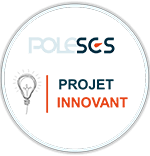Project leader
LP3 - Lasers, Plasmas et Procédés PhotoniquesPartners
GEMALTO, ENSMSE (CMP Gardanne)Funders
ANR,
COPPRINT
Laser impression of structures 2D/3D out of copper for electronics on plastic support
The potential of applications of printed electronics is extremely important and aroused an interest always growing of the industrial community. The principal scopes of application are health, the services individualized, the house automation, transport, and the distribution… Although in full rise, this industry has difficulty becoming extensive corresponding to its potential. The development of the electronics printed, and electronics on flexible support, passes in particular by the clarification of devices of digital impression reliable making it possible to print structures 2D with a resolution compatible with the targeted applications, and in an industrial environment. The goal of this project is to conceive and produce a prototype of digital impression by laser fulfilling the requirements of printed electronics. The validation of this device will be done by the realization of interconnections out of copper. Principal technology now used to print this kind of conducting lines is the transfer of ink to copper or money nanoparticules by jet of ink. This process made it possible to get interesting results but it presents certain defects which limit its use in an industrial context. These limitations are mainly related to the obligation to use very expensive metal inks with nanoparticules and of low viscosity, and requiring a stage of annealing to obtain a good conductivity. They prevent the impression of thick lines, for the applications to fort running, or of width lower than about thirty micrometers, to see around fifty in industrial conditions. Moreover, the stage of annealing does not allow yet the use of low substrates cost. Laboratory LP3 developed a process of impression per laser which it used to print of materials in solid phase and liquid, and to carry out components such as organic transistors in thin films. Certain disadvantages were identified for the impression in solid phase and from very good performances were obtained for the transfer in liquid phase. In particular, the impression of inks with money nanoparticules made it possible to carry out conducting lines of 20 μm of width at a speed of 17m/s. This approach does not remove however the stage of annealing and always requires the use of metal ink with nanoparticules. In this project we will develop an approach allowing to print copper in liquid phase on the basis of a solid copper thin film. This process will make it possible to print low materials cost, in comparison with inks, to remove the stages of annealing, to print thick lines to lead stronger currents, and to keep the resolution obtained by the impression in liquid phase. The innovation which allows the development of this technique rests on a device of laser irradiation original and the control of the phase shift of the copper film. The various stages of this project will be: 1. The control and the optimization of the mechanisms of ejection of copper in liquid phase induced by laser irradiation 2. The realization and the optimization of a prototype of impression by laser; 3. The copper realization and characterization of conducting structures; 4. Impression of circuits tests to validate the process with an industrial end-user. This project gathers three partners having expert testimonies quite specific and essential to its realization: the laboratory LP3 for the development of the process, ARMINES-CMP which will carry out the chemical, electric characterizations and mechanics of materials and the structures printed, and company GEMALTO for the definition of the technical objectives to reach compared to its applications and which will validate the process by the realization and the test of printed circuits.